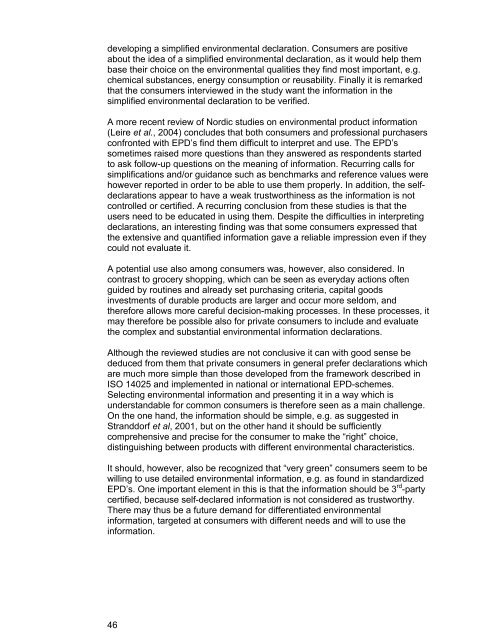Benchmarking and additional environmental information in ... - ANEC
Benchmarking and additional environmental information in ... - ANEC
Benchmarking and additional environmental information in ... - ANEC
Create successful ePaper yourself
Turn your PDF publications into a flip-book with our unique Google optimized e-Paper software.
develop<strong>in</strong>g a simplified <strong>environmental</strong> declaration. Consumers are positive<br />
about the idea of a simplified <strong>environmental</strong> declaration, as it would help them<br />
base their choice on the <strong>environmental</strong> qualities they f<strong>in</strong>d most important, e.g.<br />
chemical substances, energy consumption or reusability. F<strong>in</strong>ally it is remarked<br />
that the consumers <strong>in</strong>terviewed <strong>in</strong> the study want the <strong><strong>in</strong>formation</strong> <strong>in</strong> the<br />
simplified <strong>environmental</strong> declaration to be verified.<br />
A more recent review of Nordic studies on <strong>environmental</strong> product <strong><strong>in</strong>formation</strong><br />
(Leire et al., 2004) concludes that both consumers <strong>and</strong> professional purchasers<br />
confronted with EPD’s f<strong>in</strong>d them difficult to <strong>in</strong>terpret <strong>and</strong> use. The EPD’s<br />
sometimes raised more questions than they answered as respondents started<br />
to ask follow-up questions on the mean<strong>in</strong>g of <strong><strong>in</strong>formation</strong>. Recurr<strong>in</strong>g calls for<br />
simplifications <strong>and</strong>/or guidance such as benchmarks <strong>and</strong> reference values were<br />
however reported <strong>in</strong> order to be able to use them properly. In addition, the selfdeclarations<br />
appear to have a weak trustworth<strong>in</strong>ess as the <strong><strong>in</strong>formation</strong> is not<br />
controlled or certified. A recurr<strong>in</strong>g conclusion from these studies is that the<br />
users need to be educated <strong>in</strong> us<strong>in</strong>g them. Despite the difficulties <strong>in</strong> <strong>in</strong>terpret<strong>in</strong>g<br />
declarations, an <strong>in</strong>terest<strong>in</strong>g f<strong>in</strong>d<strong>in</strong>g was that some consumers expressed that<br />
the extensive <strong>and</strong> quantified <strong><strong>in</strong>formation</strong> gave a reliable impression even if they<br />
could not evaluate it.<br />
A potential use also among consumers was, however, also considered. In<br />
contrast to grocery shopp<strong>in</strong>g, which can be seen as everyday actions often<br />
guided by rout<strong>in</strong>es <strong>and</strong> already set purchas<strong>in</strong>g criteria, capital goods<br />
<strong>in</strong>vestments of durable products are larger <strong>and</strong> occur more seldom, <strong>and</strong><br />
therefore allows more careful decision-mak<strong>in</strong>g processes. In these processes, it<br />
may therefore be possible also for private consumers to <strong>in</strong>clude <strong>and</strong> evaluate<br />
the complex <strong>and</strong> substantial <strong>environmental</strong> <strong><strong>in</strong>formation</strong> declarations.<br />
Although the reviewed studies are not conclusive it can with good sense be<br />
deduced from them that private consumers <strong>in</strong> general prefer declarations which<br />
are much more simple than those developed from the framework described <strong>in</strong><br />
ISO 14025 <strong>and</strong> implemented <strong>in</strong> national or <strong>in</strong>ternational EPD-schemes.<br />
Select<strong>in</strong>g <strong>environmental</strong> <strong><strong>in</strong>formation</strong> <strong>and</strong> present<strong>in</strong>g it <strong>in</strong> a way which is<br />
underst<strong>and</strong>able for common consumers is therefore seen as a ma<strong>in</strong> challenge.<br />
On the one h<strong>and</strong>, the <strong><strong>in</strong>formation</strong> should be simple, e.g. as suggested <strong>in</strong><br />
Str<strong>and</strong>dorf et al, 2001, but on the other h<strong>and</strong> it should be sufficiently<br />
comprehensive <strong>and</strong> precise for the consumer to make the “right” choice,<br />
dist<strong>in</strong>guish<strong>in</strong>g between products with different <strong>environmental</strong> characteristics.<br />
It should, however, also be recognized that “very green” consumers seem to be<br />
will<strong>in</strong>g to use detailed <strong>environmental</strong> <strong><strong>in</strong>formation</strong>, e.g. as found <strong>in</strong> st<strong>and</strong>ardized<br />
EPD’s. One important element <strong>in</strong> this is that the <strong><strong>in</strong>formation</strong> should be 3 rd -party<br />
certified, because self-declared <strong><strong>in</strong>formation</strong> is not considered as trustworthy.<br />
There may thus be a future dem<strong>and</strong> for differentiated <strong>environmental</strong><br />
<strong><strong>in</strong>formation</strong>, targeted at consumers with different needs <strong>and</strong> will to use the<br />
<strong><strong>in</strong>formation</strong>.<br />
46
















